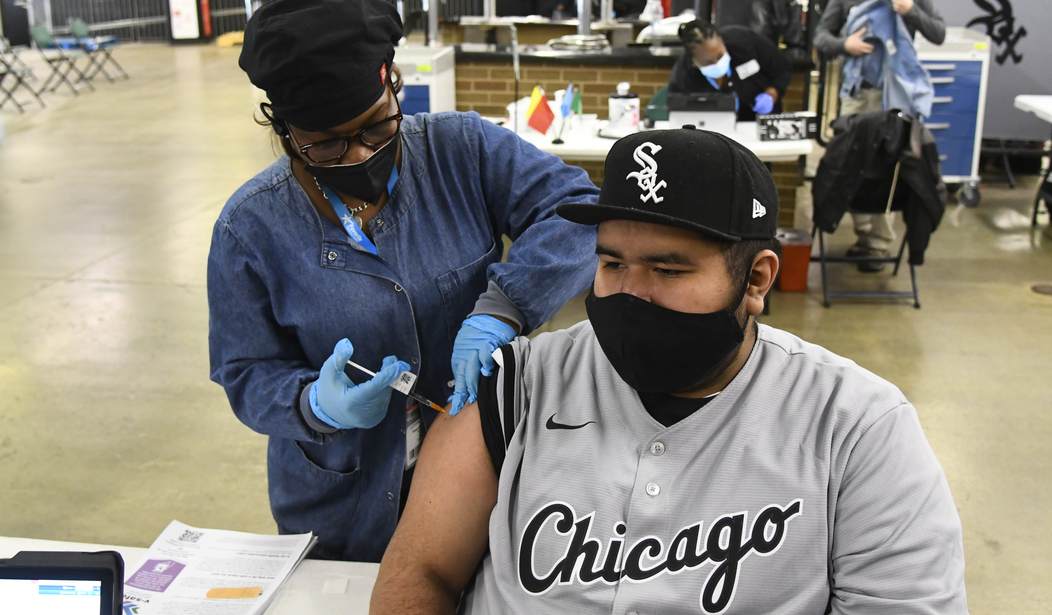A basic rule of epidemiology is that the more contagious a virus is, the greater the share of the population that has to be immunized from it in order to achieve herd immunity. Which makes sense. A germ that’s very transmissible will need to have nearly every vector of transmission blocked to keep it from eventually reaching an unvaccinated person. For a super-contagious virus like the one that causes measles, upwards of 95 percent of a group needs to be vaccinated to give the other five percent a reasonable shot at avoiding infection.
Initially we were told that immunizing 60-70 of the population from SARS-CoV-2 might be expected to provide herd immunity. Then Fauci admitted that he had told one of his little white lies about that, that the true threshold was probably more like 75-85 percent. But that was last year, when we were still coping with the original, slower-moving version of the virus. Now we’re waist-deep in the B.1.617 “Delta” variant, which is considerably more infectious than the B.1.1.7 “Alpha” variant, which was itself considerably more infectious than the virus that emerged in Wuhan in late 2019.
Which means the target for herd immunity has risen. But by how much?
Too much, one epidemiologist projects. Think 98 percent:
In scenario where R is 6 (plausible for Delta in susceptible populations without any restrictions), and vaccination reduces infection/infectiousness such that onwards transmission reduced by 85%, above calc suggests would need to vaccinate (1-1/6)/0.85 = 98% of population. 2/
— Adam Kucharski (@AdamJKucharski) July 15, 2021
If herd immunity through vaccination alone not possible, need to either: A) keep some control measures in place indefinitely, B) prepare for exit wave as measures relaxed, C) update what are already very good vaccines to be even more effective. 4/
— Adam Kucharski (@AdamJKucharski) July 15, 2021
An “exit wave” is a wave in which pretty much everyone who hasn’t already gained immunity through vaccination or previous infection ends up being infected. The UK has, for the moment, resigned itself to an “exit wave” strategy the rest of the way with COVID by proceeding towards full reopening on Monday despite the huge surge in cases they’re experiencing. The idea is that, with older people mostly protected by vaccination and younger people mostly protected by having robust immune systems, even a mega-surge won’t send many people to the hospital. It’ll be a “casedemic.” And maybe a casedemic right now isn’t the worst thing, since it’ll mean that most of the population will have gained immunity by the time the weather turns chilly again and the virus risks becoming more threatening.
But that’s risky, certainly here in the U.S. Even if you assume that 80 percent of the adult population already has immunity of one sort or the other, Kucharski’s math suggests we still have around 50 million adults in harm’s way before we can expect herd immunity. And given how quickly Delta spreads, we should expect virtually all of them to get infected sooner or later. “So basically your choices are to get vaccinated or to get COVID,” said Nate Silver in response to Kucharski’s calculations. Basically.
How many deaths can we expect from that group of 50 million? The infection fatality rate would logically be lower, maybe much lower, than it was last year when the virus was preying mostly on older people. Now it’s preying mostly on the young and will almost always lose that battle in the end. But it’s worth noting that slightly more than 20 percent of America’s senior citizens still haven’t been fully vaccinated. A study published in 2016 found nearly three percent of the U.S. population was immunosuppressed, which would amount to some nine million people. Most or all have been vaccinated by now, one would hope, but they may need a booster to keep Delta at bay.
Still a lot of dry tinder out there for the virus to burn through, in other words, a reality reflected in the fact that average daily deaths in the U.S. reached an all-time low of 174 eight days ago and have been rising ever since. They’re back to 284 per day now.
The good news is that, as far as scientists can tell, Delta isn’t more deadly than the common virus:
“As far as anyone can tell, Delta isn’t more dangerous in the sense that it causes worse disease,” Wurtz told me. “It’s a sneaky opportunist, not a mayhem man.”
Janet Baseman, a University of Washington epidemiologist, said: “I have not seen compelling evidence that the Delta variant is more severe.” Dr. Paul Sax of Brigham and Women’s Hospital in Boston told me, “This sense of greater disease severity is more anecdotal than driven by actual data.” Dr. Eric Topol of Scripps Research said, “I don’t think it makes kids sicker.”
Dr. Aaron Richterman of the University of Pennsylvania said that he did not think Delta required vaccinated parents to behave differently than they did a few weeks ago. Richterman has young children himself, and his family has not changed its behavior, he said.
We already knew that from Israel and especially the UK, no? Israel’s cases are more than 30 times higher than they were six weeks ago but deaths haven’t budged. In Britain, cases dropped below 1,600 per day in early May and now stand at more than 42,000, the equivalent of 210,000 daily in the U.S. and a number on par with what the country was seeing in mid-January. But deaths have only doubled over the same period, from an average of 15 per day to 33 now.
Still, a virus that’s so contagious that it’s destined to reach nearly every remaining unimmunized person will pile up a body count even if the vaccinated are all but invulnerable. Virologist Angela Rasmussen pointed to a new study on just why Delta is so infectious: It replicates inside the body a lot more quickly than the original SARS-CoV-2 did, which means there’s much more of the virus — literally a thousand times more — being exhaled by infected people. Bottom line:
But fully vaccinated people have high titers of neutralizing antibodies and mature memory B and T cell responses. It's a lot harder for delta to overwhelm these defenses by just throwing more virus at them.
— Dr. Angela Rasmussen (@angie_rasmussen) July 15, 2021
All this suggests we can control delta with interventions we already have at our disposal:
-Get fully vaccinated
-Consider adding other interventions too, at least when spending time with people outside your household (mask, avoid crowds, limit gatherings, ventilate, etc)— Dr. Angela Rasmussen (@angie_rasmussen) July 15, 2021
If there’s a thousand times more virus in the air in a given indoor space than there was last summer, it’s easy to see why Delta is spreading like lightning and why it’s a matter of time before an unvaccinated person encounters it. Either get vaxxed or get COVID. There’s really no third option anymore long-term.
I’ll leave you with this new communique from CPAC, which is taking the threat very seriously indeed.
Vaccine Mandates? No thanks. pic.twitter.com/Ht53HUMMsI
— CPAC 2021 (@CPAC) July 15, 2021








